
Overview
In Quest Of The Snow Leopard – Overview
In the dead of the night, in peak winter, when the mountains are covered by a snow quilt and are in deep slumber, ‘the grey ghost’ descends from the high inhospitable Himalayan heights to the lower reaches in the valley…in search of a mate or its prey – the wild mountain goats!
Snow Leopard(Ladakhi: Shan) – An enigmatic mammal capable of surviving in some of the most brutal terrains and in extreme environment conditions, is the undisputed King of the snowcapped regions. Easily the most magnificent of all the wild cats, this nocturnal cat moves like the phantom in the high mountains of Central Asia in about 12 countries including India, Pakistan, Afghanistan, China, Tibet, Bhutan and Nepal. In India, it is most prevalent in parts of Ladakh and Spiti. Due to its highly camouflaged coat and secretive habits, it is almost impossible to spot it during summers. But in winters, when the mountains are under snow it becomes relatively easier to spot them by following their walking trails in snow. An estimated 250-350 snowleopards survive today and is marked as an endangered species in India.
For wildlife enthusiasts, spotting a snow leopard is akin to coming face to face with God. It takes penance and patience and luck to actually spot it in its natural habitat. For some of them its an yearly pilgrimage they need to make to hopefully catch this charming creature at close quarters. Mid-Feb to end-March being the mating season, the probability of spotting them is high. It is normal for a male and female leopard to stay put at the same place for 2-3 days once they meet.
Our itinerary spanning 12 days is spread out across 2 locations where snow leopards have been sighted most frequently in the winters – Sham Valley and Rumbak Valley. The trip also builds in a good mix of day walks, homestay experiences and a chance of spotting other wildlife of Ladakh. We start our itinerary with 2 days of acclimatization and sightseeing in Leh before venturing into Sham Valley. We spend a couple of days scanning the slopes of Ulley for Ibex and the snow leopard. The next half of the itinerary is around Rumbak Valley divided between Rumbak and Yurutse. We end with a visit to wild Changthang to see the frozen Tsomoriri Lake.
Scanning for wildlife involves a lot of patience and long hours in the outdoors in not so favorable conditions. It is almost meditative in its approach and can be exhausting but the reward is most satisfactory. Few can explain the jubilation of spotting rarely seen wildlife in all their glory. And if it happens to be the King itself, the joy just quadruples!!.
Wildlife spotting expected: Himalayan Blue Sheep, Tibetan Argali, Asiatic Ibex, Lynx, Red Fox, Tibetan Wolf, Snow Leopard.
We do not promise sure shot spotting in these locations, but the probability is high. What we definitely promise is to give you a great and safe time as you enjoy a winter in Ladakh spotting some of its splendid wildlife.
TRIP HIGHLIGHTS
- Chance of spotting the endangered elusive ghost of snows – Snow Leopard
- High chances of spotting Blue Sheep, Tibetan Argali, Red Fox, Asiatic Ibex, Wolf
- Stay in cosy, traditional Ladakhi Homestays during trek
- Witness high altitude winter wonderland of Ladakh
- Expert ground team with knowledgeable wildlife guides
- Visit to the high altitude Frozen Tsomoriri Lake and Changthang
ITINERARY AT A GLANCE
Day 01: Arrive Leh. Rest and acclimatization
Day 02: Local Sightseeing around Leh
Day 03: Early morning drive to Ulley/Hemishukpachen. Wildlife spotting
Day 04: Ibex and snowleopard Spotting at Ulley
Day 05: Ibex and snowleopard Spotting at Ulley
Day 06: Drive to Rumbak. Snowleopard spotting
Day 07: Snowleopard spotting
Day 08: Walk to Yurutse. Snowleopard spotting
Day 09: Return to Rumbak. Snowleopard spotting
Day 10: Drive to Tsomoriri
Day 11: Return to Leh
Day 12: Transfer to Airport. Departure
Cost Inclusions
In Quest Of The Snow Leopard – Cost Details
COST:
INR 82500 + 5% GST per person – Indians
USD 1250 + 5% GST per person – Foreigners
COST INCLUDES
- Entire Accommodation during the trip – Guesthouses, homestays
- Experienced Wildlife and outdoor Crew: Local knowledgeable wildlife expert, Qualified Trip Leader
- Food: All Meals on the trip
3 meals per day – Breakfast, Lunch, Dinner and beverages - Road Transportation: All Transfers as mentioned in the itinerary
- Permits and Taxes:
ALTOA Fee and Wildlife Fees
COST EXCLUDES
- International Airfares and domestic airfares to and out of Leh
- Personal equipment and sleeping bags
- Any additional transport or activities apart from the trip itinerary
- Travel Insurance
- Expenses rising through unforeseen conditions like bad weather, natural calamities, flight cancellations, etc
- Rescue and evacuation services
- Expenses of any personal nature like phone calls, drinks, cigarettes, souvenirs, laundry, etc
- Tips
- Anything not explicitly mentioned in the Cost inclusions
- 5% GST
Itinerary
In Quest Of The Snow Leopard – Itinerary
Day 01: Arrive Leh. Rest and acclimatization
Leh situated at an average altitude of 3500m is mostly all cloaked in white with some hues of red and brown, in the peak of winter. Just landing into one of the World’s highest airports is itself a special experience. You fly over the Great Himalayan range and then over the arid part to land in Leh. Kushok Bakula Rinpoche airport is a small airport which is mostly a defence base used by the Indian Air Force. Civilian flights also use the same airport for their functioning.
The extreme nip in the air is hard to miss as you walk out of the aircraft and get into the buses. The temperatures in Leh are normally in the range of -12 to -18 degree celsius. Always a good idea to exit the aircraft wearing a warm jacket and beanie to not get affected by the sudden drop in temperature and air pressure. Look out for a placard reading ‘Adventure Sindbad’ as you exit the airport terminal. Our representative will pick you up and drive you to your hotel in Leh, our base camp for the next 2 days. Complete rest and no activity is recommended on the first day. Lots of warm water, good food and rest works well to adjust your body to the rarefied oxygen levels. Comprehensive trip briefing late afternoon, post lunch. Stay warm throughout.
Driving Time: 15 mins
Meals: BLD, Overnight Leh Guesthouse
Day 02: Leh Sightseeing and Acclimatization
Your bodies are slowly getting acclimatized to high altitude and extreme cold conditions. We step out today mostly in taxis for a sightseeing tour of some monasteries and palaces around Leh. You might have seen some of them in the Summer. But winter landscape in Leh is a totally dramatic view. We cover Thiksey monastery and Shey palace. Thiksey monastery is famous as the ‘mini potala’ because of its likeness to the Potala Palace in Lhasa, Tibet. The main attraction of this place is the Maitreya temple with an exquisite 2 storeyed statue of the Future Buddha. The terrace of the Thiksey monastery affords outstanding views of the Indus Valley.
Shey used to be the erstwhile capital of Ladakh and boasts the Shey palace atop a hill. It houses the mega statue of Buddha Shakyamuni and some mega chortens. We are back to Leh for lunch and some shopping in preparation of our trek starting the next day. Most of the antique shops are closed in Leh town, and only a handful of restaurants and a book shop operate during winters.
Driving Time: 2-3 hrs
Meals: BLD, Overnight Leh Guest House
Day 03: Early morning drive to Ulley/Hemishukpachen. Wildlife spotting
Ulley village is where a lot of snow leopard sightings happen during the winters. The walk to Ulley is about 2 hrs from Yangthang. We start early after breakfast and walk to the village of Ulley and spend the whole day scanning the white slopes for snow leopard activity. Our main wildlife guide would be using a scope for continuous scanning. A high chance of spotting other mountain sheep including Ladakh Urial(Shapo) and Ibex on the walk as well as at Ulley. If we dont get accommodation in Ulley we may stay at Hemishukpachen which is the neighbouring village.
Driving time: 2 hrs
Meals: BLD, Overnight Homestay.
Day 04 and 05: Ibex and snowleopard Spotting at Ulley
We spend the next 2 days resuming our full day spotting activity on the snow slopes.
Meals: BLD, Overnight Homestay
Day 06: Drive to Rumbak. Snowleopard spotting
After one last session of wildlife spotting, we head to Rumbak Valley with stopovers at Indus and Zanskar confluence at Nimo and at Gurudwara Pathar Sahib. Rumbak in Hemis National Park is the most popular area for spotting the elusive ghost of snow! Over the years, it has become very famous with wildlife and photography enthusiasts and attracts a huge no. of campers. The Wildlife department has recently regulated the no. of people entering these fragile zones, where the wild cat treads. Normally, depending on the latest movements of the snow leopard, the wildlife guides discuss and choose one spot to move to for spotting. We sit there and continuously scan the slopes for signs of trodden trails or movement. High chance of spotting blue sheep, red fox and ofcourse the snow leopard itself.
Driving time: 2 hrs
Meals: BLD, Overnight Homestay
Day 07: Snowleopard spotting at Rumbak
Continue spotting and enjoying the snow clad mountains and the silence of the surroundings
Meals: BLD, Overnight Homestay
Day 08: Walk to Yurutse. Snowleopard spotting
Yurutse is the last village on the way towards Ganda-La. It is famous as the 1 house village in the Rumbak area. It is also a great place for spotting Lynx and Tibetan Argali! Lynx is much smaller than a snow leopard, and is distinctly recognizable bacause of its pointed Ears. They are believed to be more rare to spot than the snow leopard. The Tibetan Argali(Ladakhi:Nyan), is the biggest of the mountain goats, the male weighing almost 100 Kg with massive, wrinkled horns. These 2 mammals can be spotted only around the slopes of Yurutse. Depending on the rush and availability we either stay at the home in Yurutse or camp outside in the grounds beside the house. The trek from RUmbak to Yurutse is beautiful over a gradual slope.
Trekking Time: 2 hrs
Meals: BLD, Overnight Homestay.
Day 09: Return to Rumbak. Snowleopard spotting
We descend to Rumbak and continue our spotting quest.
Meals: BLD, Overnight Homestay.
Day 10: Drive to Tsomoriri
Early morning with our permits for Changthang border areas in hand we head to Tsomoriri Lake via Chumathang Hot springs. Ladakh has many areas with Hot springs, a natural wonder especially in these extreme cold regions. We get to witness the hot geysers with boiling waters just beside the frozen Indus River. Truly a marvel. There are many bathrooms built with small tubs where you can dip into and get a jacuzzi feel. Enjoy a hot water bath with -25 degree celsius outside. We have lunch at Chumathang and head to Tsomoriri lake for our night stay.
The drive to Changthang from Leh is simply amazing esp in winter. The starkness so profound that it speaks to you. Good chances of spotting wildlife on the way, esp red fox, bharals and Tibetan Wild Asses(Kiang).
Meals: BLD, Overnight Homestay.
Day 11: Return to Leh
We spend the morning enjoying the beautiful scenery and head up a small hillock just above Korzok Village to enjoy panoramic views of the entire Lake surrounded by snow peaks. Prominent ones among them are Chamsher, Lungsher Kangri and Mentok Kangri.
After Breakfast we head back to Leh with a lunch break at Chumathang. Evening closing dinner party.
Meals: BLD, Overnight Leh Guesthouse.
Day 12: Transfer to Airport. Departure
We make an early start and drive to the airport for our flight back to Delhi. Trip Ends!
Meals: B
Gallery
In Quest Of The Snow Leopard – Images
- Birds of Ladakh
- Chukor – Birds of Ladakh
- Snow Leopard sighted
- 17th Century Leh Palace
- View from Monastery Terrace
- Tibetan Mastiff
- Spotting Equipment in place
- Red Fox sighted
- Snow Leopard Sighters
- In quest of the Snow Leopard
- Spotters scanning the slopes on a cloudy morning
- Much needed warmth
- Yaks
- Snow leopard
- In quest of the Snow Leopard – Adventure Sindbad
- Tibetan Argali- Skull weighing 20Kgs








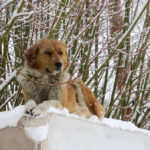
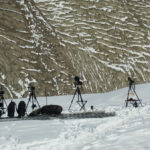





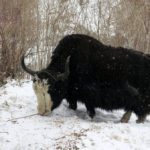

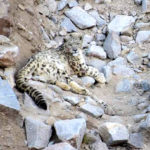



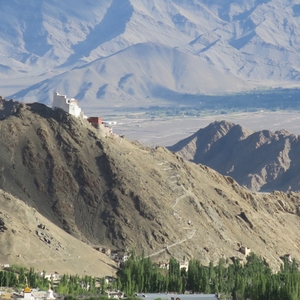
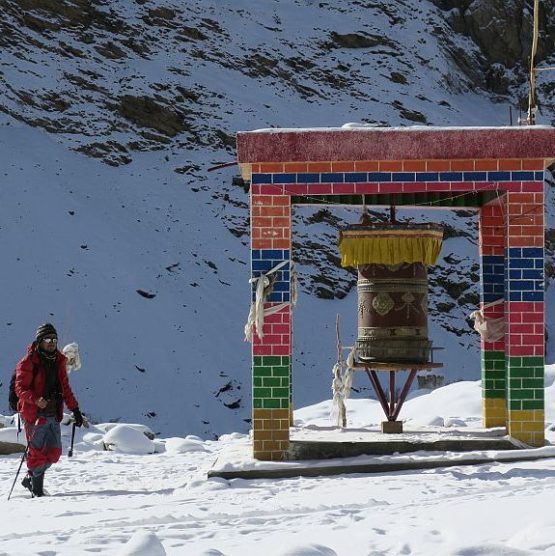




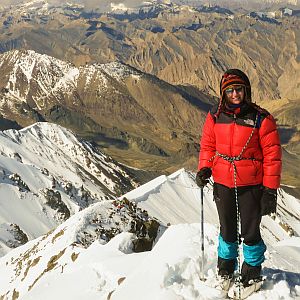
Reviews
There are no reviews yet.